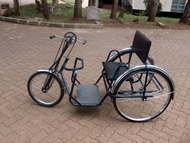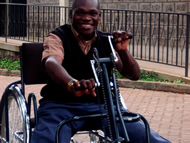The Figure-Eight Drive: A Two-Speed Drivetrain for Handcycles in the Developing World
Mario Bollini
ABSTRACT
The Figure-Eight Drive is a novel handcycle drivetrain designed specifically for the developing world. It offers users two forward motion gear ratios that can be switched between by changing the direction of pedaling. The drivetrain was designed at the Massachusetts of Institute of Technology and was successfully implemented and tested during the summer of 2007 at the Association for the Physically Disabled of Kenya in Nairobi, Kenya. The Figure-Eight Drive has been well received by handcycle users and manufacturers in the developing world because of its simplicity, low-cost, and significant improvement in mobility over current handcycles in production.
Keywords:
handcycles; developing countries; mobility; efficiency; power output
PURPOSE
While wheelchairs are ubiquitous in the western world, they are biomechanically inefficient (1) and are difficult to operate over rough terrain and long distances. Instead of wheelchairs, the disabled in developing countries frequently use locally designed and manufactured handcycles as their primary means of ambulation. While these handcycles offer a significant biomechanical advantage over wheelchairs, they are frequently available only in single-speed configurations. This single gear makes it impossible for users to navigate hilly terrain. While multi-geared systems that make use of bicycle derailleurs are available, these systems are uncommon because they are expensive, fragile, and difficult to use while using the arms to pedal and steer. The Figure-Eight Drive is an implementation of a retro-direct bicycle drivetrain that allows users to change between two gears, one high and one low, simply by changing the direction of their pedaling. Both directions result in forward motion, providing users with a simple and robust two-speed drivetrain.
DESIGN AND DEVELOPMENT
I designed the Figure-Eight Drive during the spring of 2007 at the Massachusetts Institute of Technology as a member of the biomechanics group of the class Wheelchair Design for Developing Countries. The system utilizes two bicycle chains, one in a loop such as a chain found on standard single speed handcycles and another in a figure-eight loop on the opposite side of the steering column. The chain in the standard loop (henceforth to be referred to as the O-side chain) is looped around a bicycle crank at the top of drivetrain, and around a standard freewheel at the bottom wheel hub. The figure-eight chain (henceforth to be referred to as the 8-side chain) is looped around a reverse-mounted freewheel at the top of the drivetrain near the pedals, and around a forwards-mounted freewheel at the bottom wheel hub. The slack side of the 8-side chain is passed through a steel tube to prevent it from grinding against the return chain
When pedaling forwards, the O-side chain engages, driving the tricycle forwards just as it would on a single-speed handcycle. The freewheel at the top of the 8-side chain ratchets and does not engage, leaving the 8-side chain stationary. This is the high gear of the Figure-Eight Drive. When pedaling backwards, the O-side chain freewheels, just as one’s bicycle chain freewheels when one pedals backwards on bicycle. The freewheel on the top of the 8-side chain, however, engages and drives the 8-side chain backwards. Because this chain is in a figure-eight loop, the backwards motion of the chain drives the handcycle forwards. This is the low gear of the Figure-Eight Drive. Thus the drivetrain offers users one high and one low gear, switch able between simply by changing the direction of pedaling.
While the two chain solution allows users to ambulate and coast in the forward direction, the chains lock when the drive wheel rotates backwards, meaning that users cannot move in the reverse direction. Though this is convenient in that one can remove one’s hands from the pedals while climbing without fear of rolling backwards down the hill, it dramatically reduces the mobility of the handcycle. In order to allow users to move their handcycles in reverse, I designed the fork to allow the steering column to be rotated 180 degrees, allowing users to both freewheel and ambulate backwards.
A proof-of-concept prototype was constructed at MIT in order to validate the design. I was then granted a MIT Public Service Center fellowship to spend the summer of 2007 in Nairobi, Kenya to implement the Figure-Eight Drive. In Nairobi, I worked with the Association for the Physically Disabled of Kenya (APDK), a local NGO that manufactures and distributes wheelchairs and handcycles across Kenya. At APDK, I worked to make sure that the Figure-Eight Drive could be constructed entirely out of bicycle components that were already in use on current single-geared handcycles. By using only simple bicycle parts, namely single-geared freewheels along with standard hubs, spindles, and ball bearings and by making sure that only basic welding and bending is required, we guaranteed that the drivetrain could be constructed and serviced throughout the developing world. In my first two weeks of work at APDK, we constructed three prototype generations of the Figure-Eight Drive, the last of which is considered production ready. Once streamlined, the Figure-Eight drive’s assembly, including the fork modifications, required only one more hour than APDK’s current single-speed handcycle. Approximately $3 of additional parts and materials are used than the single-speed. To put this in perspective, the single-speed retails for $200, while the multi-speed derailleur system retails for $300. It can be seen that for only a marginal increase in cost, users can purchase a significantly more useable and effective mobility aid.
TESTING AND PERFORMANCE
I was fortunate that APDK’s compound has a constant flux of experienced handcycle users. I frequently pulled these users aside, discussed their current mobility aids, and after explaining the Figure-Eight Drive to them, had them test the prototype around the compound. In addition to dozens of these informal tests, I also performed formalized comparison testing among eight experienced handcycle users and four handcycle technicians in order to have written documentation comparing the Figure-Eight Drive to current single and multi-geared handcycles. All testing results, from both the informal and formal surveys, came back extremely positive in favor of the Figure-Eight Drive. Many users reported that the prototype system was the difference between being able to independently move up a hill and needing to have someone push them up it.
In addition to on-site testing, one handcycle equipped with the Figure-Eight Drive was given permanently to a handcycle user for long term testing while I was at APDK. The user had come to the APDK compound to pick up a single-speed handcycle that had been manufactured for him, but before he left I had had him try the Figure-Eight Drive. He liked the new drivetrain so much that he refused to go home with the single-speed system, instead demanding that we construct a Figure-Eight Drive just for him. We did, making him our first long term testing subject. Since I’ve returned from APDK, three other handcycles with the drivetrain were manufactured and delivered to users for long-term evaluation. So far all of the long-term testing results have come back positive.
While user testing took first priority, I also performed extensive durability testing of the drivetrain to ensure that the modifications to the fork and the routing of the 8-side chain did not shorten the life span of the handcycle. I spent four weeks driving the handcycle over the roughest paths in the neighborhood of the APDK compound, purposely riding into every pothole, bump, and curb. In addition to this rigorous riding, I also constructed a testing stand that utilized an electric drill and a custom coupling to artificially manipulate the drivetrain. Using this testing stand I was able to simulate over 100 km of uphill riding on the 8-side chain, alleviating concerns about chain wear in the routing tube.
IMPLICATIONS
In September of 2007, APDK presented the Figure-Eight Drive at the Pan African Wheelchair Congress in Arusha, Tanzania. It was extremely well received; over 100 compact disks containing manufacturing instructions were distributed to interested African wheelchair and handcycle manufacturers. The Figure-Eight Drive has also been manufactured locally Tanzania and the Philippines. APDK is currently awaiting the results of the long term testing before putting the Figure-Eight drive into full production, though it is currently available as a made-to-order option.
The Figure-Eight Drive has proven to be an effective replacement for both single and multi geared handcycle systems. It allows users to travel over terrain that is impossible to traverse with single speed handcycles. It is cheaper to manufacture, easier to use, and significantly more robust than current derailleur based handcycles. User feedback continues to be extremely positive, demonstrating the system’s ability to meet user needs better than current systems. The Figure-Eight Drive is constructed using materials and manufacturing techniques that are ubiquitous across the developing world, making it an accessible mobility solution for handcycle users worldwide.
ACKNOWLEDGEMENTS
I would like to thank the MIT Mobility Laboratory, the MIT Public Service Center, and the Association for the Physically Disabled of Kenya. Without the support of these organizations, the Figure-Eight Drive’s development would not have been possible.
REFERENCES
- Woude LHV et al, (1986). Wheelchair ergonomics and physiological testing of prototypes, Ergonomics, 12, 1561-1573.
CONTACT INFORMATION
Mario Bollini, Class of 2009
Department of Mechanical Engineering
Massachusetts Institute of Technology
mbollini@mit.edu
586-216-9030
3 Ames Street, Box 272
Cambridge, Massachusetts 02142
Additional media and information about the Figure-Eight Drive can be found at http://web.mit.edu/mbollini/www/tricycle/.



